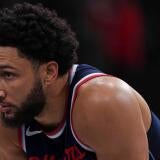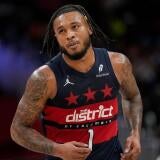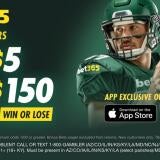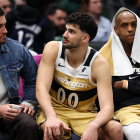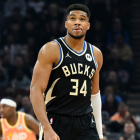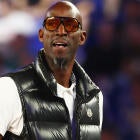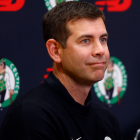Wait, what just happened? NBA offseason madness leaves many questions
It was a feeding frenzy and at the end we're left with a number of questions trying to figure out just what in the name of everything Russell happened.
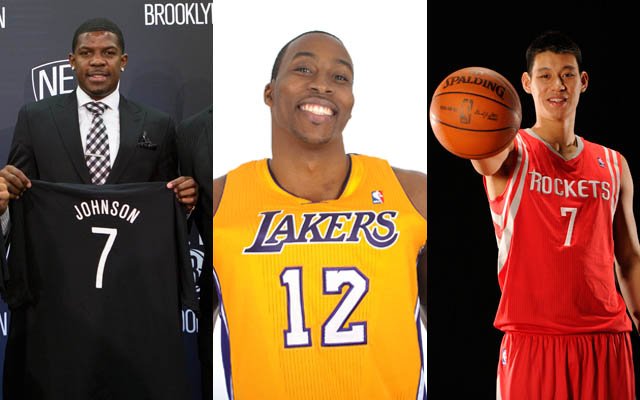 |
| All of this happened in the span of a month. (Getty Images) |
72 hours. $400 million. That's how much and how long it took the NBA to go off on a spending binge as soon as free agency started, less than a year after the new CBA. And that was just the amount of money taken on in new deals. A lot of teams took on new money from old contracts.
It was a feeding frenzy and at the end we're left with a number of questions trying to figure out just what in the name of everything Russell happened.
1. How did the Lakers pull this off?
We know the nuts and bolts. Draft picks and cash to the Suns for Steve Nash. Andrew Bynum and picks to Philadelphia and Orlando for Dwight Howard.
But did that really just happen?
The Lakers, one of the most cap-maxed teams in the league, acquired a two-time MVP unrestricted free agent and the biggest available star in the league. They went from a team circling the championship drain, to being right there with the Thunder for best in the West.
It's easy to say that the Lakers were planning for this the entire way, especially with how the Lamar Odom exception played a part (sticking the knife in deeper to Dallas), but it's hard to envision this as some sort of master plan with as many ways it could fall through. You might think both players just came available and the Lakers just happened to be there with the deals necessary.
But how do they keep doing this? Yes, the Lakers are the best franchise of the past thirty years and have a world of market advantages and an owner willing to spend, but there are other teams in the same position who don't come nearly as close to landing these deals once, let alone with the regularity. Even Lakers fans I talked to after the trade were left with a shrug and a simple "We don't even know, we just kind of do these things."
Yes they do.
2. How could the Knicks let Jeremy Lin go?
It's not that Lin's not overpaid relative to resume. He is. And it's not that ducking the luxury tax for that poison pill isn't a smart move, it is.
But why only this time? Why only Lin?
We'll never get a straight answer from the Knicks about whether this was a business decision or a personal decision brought on by how the negotiations with the Rockets went down. We'll never know what part Carmelo Anthony had in the decision or more likely how much CAA dictated the decision based off protecting their agenda.
And we won't even really know if the Knicks are truly concerned with the luxury tax in 2015 until we get there and see what they pay. But we're always going to wonder why the team to pay the most luxury tax in history elected to choose their fan-favorite dynamic star point guard to be the breaking point.
3. Is all this worth it for Brooklyn?
There's a line of thought that follows this train of logic:
Deron Williams was imperative at all costs.
Joe Johnson helped get Deron Williams, therefore, Joe Johnson is worth it.
Gerald Wallace had already been acquired or a draft pick. Therefore, keeping him was retaining value on that draft pick, regardless of contract.
The Nets were already capped out when negotiations with Brook Lopez really began. Therefore, the only way they were going to get a capable center for above the veteran minimum for the next five years was to either liquidate one of the players they want to get under the cap or re-sign Lopez which meant matching bigge offers.
In the end, we have one of the biggest spending sprees in any one summer for an NBA team. And at the end, they still don't look like a championship team. But there's also a line of thought that says that just being good heading into Brooklyn is what matters, starting off on the right foot with the new fanbase and cementing themselves as a winning team matters more than paying a good dollar for win ratio.
It had better be worth it. Prokhorov may have the money to fit the bill, but overpaying drastically for great-not-elite doesn't seem like a very sound business model.
4. Did Dallas do enough?
The Mavericks remade their roster with a combination of young players like Darren Collison and O.J. Mayo and veterans like Chris Kaman and Elton Brand. They still have Dirk Nowitzki and Shawn Marion, and have some bench strength with younger players.
Is this enough to keep their streak of 50-plus-win seasons alive? The Mavericks whiffed hard on Deron Williams and didn't get desperate to acquire a new star. They tinkered and adjusted, and in the end came away with a pretty good team. Is that enough in today's superstar-laden NBA for them to stay in the top bracket of teams in the West, or will their inability to reel in the fish leave the cupboards bare?
We've never seen the organization have to react to a team dismantling itself, and we may not this year. But it's something to watch.
The lockout was suppossedly done in pursuit of competitive balance, small-market rejuvenation, to level the playing field and help teams keep stars. In reality, it was just about money, and we all know that, but let's try on the league's clown pants for a second.
Orlando is in ruins, having been Dwight-bombed back to the stone age. The Lakers added Steve Nash and Dwight Howard, Boston added Jason Terry and Courtney Lee, the Sixers got Andrew Bynum, Brooklyn added Joe Johnson and re-signed Williams, Lopez, and Wallace, the Knicks added Jason Kidd, Marcus Camby, got J.R. Smith for a discount and added Raymond Felton, and the Clippers threw on Jamal Crawford.
Meanwhile, Memphis added Jerryd Bayless, the Suns added Goran Dragic and Michael Beasley, and... that's about it.
The championship contenders still feature two small-market teams in Miami and Oklahoma City, but the Lakers hold a shadow over everything and if they reach their potential, they'll be the favorites. Right behind them are the Celtics along with the Spurs. So there's a balance here. But the trend is disconcerting. We thought for a while that the CBA's intention had worked with regards to the more punitive luxury tax. There's still two more years to go before teams have to start making the tough decisions, but so far the big markets haven't blinked.
We saw even more star accumulation in the big markets this summer. So what exactly is the point, again?



